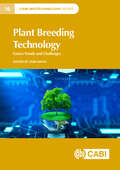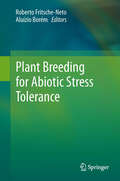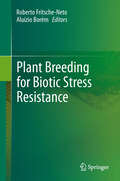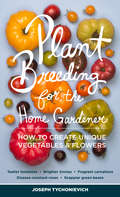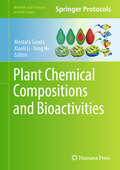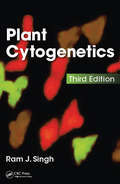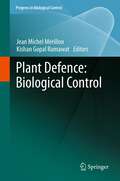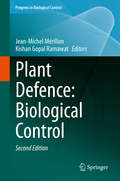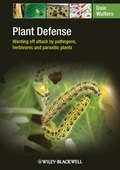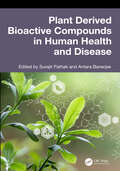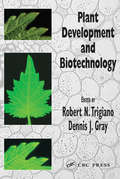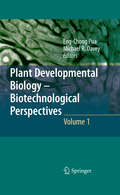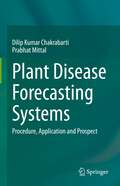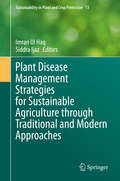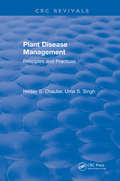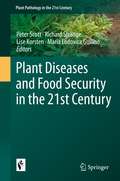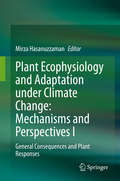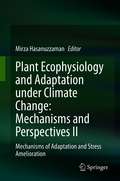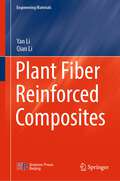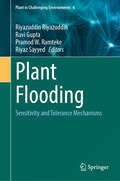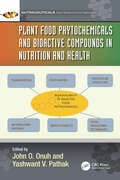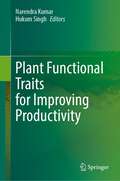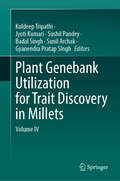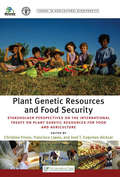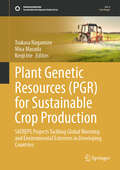- Table View
- List View
Plant Breeding Technology: Future Trends and Challenges (CABI Biotechnology Series)
by Zeba KhanThis book highlights the latest and most exciting technological tools for plant breeding that are becoming the staple of all crop improvement programs. Using case studies and an evidence-based approach to examine the current status of each technique, the book discusses the challenges so far uncovered and future trends. Crop improvement relies on modulating the genes and genomic regions underlying key traits, either directly or indirectly. Direct approaches include overexpression, RNA interference, and genome editing, while conventional breeding constitutes the indirect approach. The integration of cutting-edge tools and technologies has the potential to expedite improvements in crop species. Innovations such as next-generation sequencing, high-throughput genotyping, precision editing, and the utilization of space technology to accelerate growth have opened new avenues in crop improvement programs, aimed at delivering new crop varieties capable of resilience to a variety of challenges. The book presents a systematic guide to various genomics approaches deployed for trait discovery and improvement in crop species. The chapters comprehensively cover each application, its advantages, and disadvantages, and its potential for improvement, supported by illustrative examples. The book: · Emphasizes the latest scientific and technological tools which are becoming the norm in all major crop improvement programs · Explores innovative approaches and cutting-edge technologies utilized in the development and improvement of climate-resilient crops. · Each chapter is supplemented with ample illustrations to clarify and summarize the key points and provides an easy-to-understand overview of the most important concepts, applications and advances in crop improvement technologies.
Plant Breeding for Abiotic Stress Tolerance
by Roberto Fritsche-Neto Aluízio BorémThe rapid population growth and the increase in the per capita income, especially in the group of emerging countries referred to as BRIC countries (Brazil, Russia, India, China and South Africa) has created huge pressure for the expansion of the agricultural growing area and the crop yields to meet the rising demand. As a result, many areas that have been considered marginal for growing crops, due to their low fertility, drought, salinity, and many other abiotic stresses, have now been incorporated in the production system. Additionally, climate change has brought new challenges to agriculture to produce food, feed, fiber and biofuels. To cope with these new challenges, many plant breeding programs have reoriented their breeding scope to stress tolerance in the last years. The authors of this book have collected the most recent advances and discoveries applied to breeding for abiotic stresses in this book, starting with new physiological concepts and breeding methods, and moving on to discuss modern molecular biological approaches geared to the development of improved cultivars tolerant to most sorts of abiotic stress. Written in an easy to understand style, this book is an excellent reference work for students, scientists and farmers interested in learning how to breed for abiotic stresses scenarios, presenting the state-of-the-art in plant stresses and allowing the reader to develop a greater understanding of the basic mechanisms of tolerance to abiotic stresses and how to breed for them.
Plant Breeding for Biotic Stress Resistance
by Roberto Fritsche-Neto Aluízio BorémExperience shows that biotic stresses occur with different levels of intensity in nearly all agricultural areas around the world. The occurrence of insects, weeds and diseases caused by fungi, bacteria or viruses may not be relevant in a specific year but they usually harm yield in most years. Global warming has shifted the paradigm of biotic stresses in most growing areas, especially in the tropical countries, sparking intense discussions in scientific forums. This book was written with the idea of collecting in a single publication the most recent advances and discoveries concerning breeding for biotic stresses, covering all major classes of biotic challenges to agriculture and food production. Accordingly, it presents the state-of-the-art in plant stresses caused by all microorganisms, weeds and insects and how to breed for them. Complementing Plant Breeding for Abiotic Stress Tolerance, this book was written for scientists and students interested in learning how to breed for biotic stress scenarios, allowing them to develop a greater understanding of the basic mechanisms of resistance to biotic stresses and develop resistant cultivars.
Plant Breeding for the Home Gardener: How to Create Unique Vegetables and Flowers
by Joseph TychonievichBrighter zinnias, fragrant carnations, snappier green beansPlant Breeding for the Home Gardener makes it easier than ever to breed and grow your own varieties of vegetables and flowers. This comprehensive and accessible guide explains how to decide what to breed, provides simple explanations on how to cross plants, and features a basic primer on genetics and advanced techniques. Case studies provide breeding examples for favorite plants like daffodils, hollyhocks, roses, sweet corn, and tomatoes.
Plant Chemical Compositions and Bioactivities (Methods and Protocols in Food Science)
by Xiaoli Li Yong He Mostafa GoudaThis volume provides food researchers with advanced destructive and non-destructive techniques for measuring the chemical composition, functional bioactivities physicochemical changes, and explaining the functional mechanisms for facilitating the tracking of the functional molecules during the different industrial processes. Chapters guide readers through sample preparation emerging extraction technologies protocols analytical methodologies for phytochemicals profiling, multi way models in food data analysis, and the integration of omics for biochemical analyses understanding. Written in the format of the Methods and Protocols in Food Science series, the chapters include an introduction to the respective topic, list necessary materials and reagents, detail well established and validated methods for readily reproducible laboratory protocols and contain notes on how to avoid or solve typical problems. Authoritative and cutting-edge, Plant Chemical Compositions and Bioactivities aims to ensure successful results in the further study of this vital field.
Plant Cytogenetics
by Ram J. SinghCytogenetics plays an important role in understanding the chromosomal and genetic architecture of plant species. Plant Cytogenetics, Third Edition follows the tradition of its predecessors presenting theoretical and practical aspects of plant cytogenetics. Chapters describe correct handling of plant chromosomes, methods in plant cytogenetics, cell division, reproduction methods, chromosome nomenclature, karyotype analysis, chromosomal aberrations, genome analysis, transgenic crops, and cytogenetics in plant breeding. This new edition begins with a brief introduction on the historical aspect of cytogenetics and flows directly into handling of plant chromosomes by classical and modern cytological techniques, classical Mendelian Genetics, brief description of cell division, and chromosome identification by karyotype analysis. The comprehension of cytogenetics is incomplete without information on the role of aneuploidy in associating a gene on a particular chromosome, and the book covers these methodologies as a primary topic. Covering classical to modern cytogenetics, the book presents to the reader the crucial role of cytogenetics in improving crops.
Plant Defence: Biological Control
by Kishan Gopal Ramawat Jean Michel MérillonTo meet the challenge of feeding ever increasing human population, efficient, economical and environment friendly disease control methods are required. Pests are responsible for heavy crop losses and reduced food supplies, poorer quality of agricultural products, economic hardship for growers and processor. Generally, chemical control methods are neither always economical nor are they effective and may have associated unwanted health, safety and environmental risks. Biological control involves use of beneficial microorganism to control plant pathogens and diseases they cause and offers an environmental friendly approach to the effective management of plant diseases. This book provides a comprehensive account of interaction of host and its pathogens, induced host resistance, development of biological control agents for practical applications, the underlying mechanism and signal transduction. The book is useful to all those working in academia or industry related to crop protection.
Plant Defence: Biological Control (Progress in Biological Control #22)
by Kishan Gopal Ramawat Jean-Michel MérillonInsects, pests and weeds are responsible for substantial loss of crops and reduced food supplies, poorer quality of agricultural products, economic hardship for growers and processor. Generally, chemical control methods are neither always economical nor are they effective and may have associated unwanted health, safety and environmental risks. Biological control involves use of beneficial biological agents to control pests and offers an environmental friendly approach to the effective management of plant diseases and weeds. The chapters are written by well recognized group leaders in the field. This book provides a comprehensive account of interaction of host and pests, and development of biological control agents for practical applications in crops management utilizing inherent defence mechanism, induced stimulation and biological control agents. The contents are divided into the following sections: General biology of plant defence, Use of natural compounds for biological control, Use of biological agents, Mechanism of action and Commercial aspects. The book will be useful for academicians, researcher and industries involved in study and manufacturing these products.
Plant Defense: Warding off attack by pathogens, herbivores and parasitic plants
by Dale WaltersPlants are sources of nourishment for thousands of fungi, bacteria, invertebrates, vertebrates, and other plants. Plants possess a truly remarkable diversity of mechanisms to fend off attackers and recent research has shown just how complex and sophisticated these defense mechanisms can be. Plant Defense provides comprehensive coverage of the range of different organisms that plants need to fend off, describes how plants coordinate their defenses against multiple attacks, explains the evolution of defense in plants, and how plant defences are exploited in crop protection strategies. Plant Defense: Covers plants’ defenses against pathogens, pests, and parasitic plants: together in one book Brings together succinct, cutting edge information in a user-friendly format Gives an understanding of how plants ward off attacks from multiple enemies Is written by Dale Walters, an internationally known and respected researcher and teacher in crop protection, who distils his wealth of knowledge in a novel and exciting way Is an essential purchase for all those involved in plant protection around the globe Plant Defense is primarily designed for use by upper undergraduates and post graduates studying crop protection, agricultural sciences, applied entomology, plant pathology, and plant sciences. Biological and agricultural research scientists in the agrochemical and crop protection industries, and in academia, will find much of great use in this excellent new book. Libraries in all universities and research establishments where agricultural and biological sciences are studied and taught should have multiple copies of this very valuable book on their shelves.
Plant Derived Bioactive Compounds in Human Health and Disease
by Surajit Pathak Antara BanerjeeThis book offers a comprehensive review of the multifaceted role of phytochemicals in promoting human health and combating diseases. The initial chapters introduce phytochemicals, navigate the natural health landscape, and provide a foundational understanding of these bioactive compounds. The book unfolds the role of phytochemicals as a formidable defense against oxidative stress and explores the unique health benefits and nutritional significance of phytochemicals found in fruit peels. The subsequent chapters further discuss the therapeutic potential of phytochemicals, detailing their role in combating multidrug-resistant bacterial infections and modulating critical pathways in inflammation and cancer. This book also highlights the novel treatment strategies for amyloidosis using natural products, as well as the fascinating interplay between natural compounds and biogenic nanoparticles in the context of polycystic ovarian syndrome (PCOS). Further exploration includes the impact of plant-derived compounds on cancer stem cells and the recent advancements in ethnopharmacology for age-related brain disorders. Each chapter provides a thorough and up-to-date analysis of research findings, clinical applications, and future directions within the field. By presenting a holistic view of the diverse functions and benefits of phytochemicals, this book aims to inspire further investigation and innovation in this dynamic area of research, ultimately contributing to enhanced human health and well-being.
Plant Development and Biotechnology
by Robert N. Trigiano Dennis J. GrayBiotechnology revolutionized traditional plant breeding programs. This rapid change produced new discussions on techniques and opportunities for commerce, as well as a fear of the unknown. Plant Development and Biotechnology addresses the major issues of the field, with chapters on broad topics written by specialists. The book applies an informal s
Plant Developmental Biology - Biotechnological Perspectives
by Michael R. Davey Eng Chong PuaUnderstanding the mechanisms whereby plant development is regulated is crucial for crop improvement using genetic engineering. This work, comprising two volumes, reviews recent advances in plant developmental biology and explores the possibility of their biotechnological applications. Volume 2 focuses on development-related areas, including tissue culture (somatic and microspore embryogenesis, somaclonal variation), plant processes (photosynthesis, seed maturation and seed proteins, fatty acids, vitamins, alkaloids, flower pigments and scent), signalling (amino compound-containing lipids, auxins, cytokinins and light), and molecular genetics of developmental regulation (RNA silencing, DNA methylation, epigenetics, activation tagging, homologous recombination and synthetic promoter engineering). This work is a key reference for plant breeders, researchers and graduate students in the fields of plant biotechnology, agronomy, horticulture, genetics and functional genomics, and cell and molecular biology.
Plant Disease Forecasting Systems: Procedure, Application and Prospect
by Dilip Kumar Chakrabarti Prabhat MittalThis book focus on creating popularity and interest in modeling, derivation of equations for plant disease forecasting or construction and use of Web-based Expert Systems among plant pathologists. This book covers descriptions of many historic plant disease epidemics, various forecasting systems and methods of their construction, instruments required for study of plant disease epidemics, widely used commercial forecasting systems and present global scenario of forecasting.In the human history plant disease epidemics have brought unsurmountable misery many a times. Still breaking out of epidemic in any time in any part of the world is a stark reality. The panic spraying of chemical pesticides is not a panacea. Only the IPM technology may give relief. This technology if backed by the disease forewarning system may yield the desired results. Hence, an in depth understanding of plant disease forecasting system and its successful implementation may bring the global food security. This title provides a useful background for all students, practitioners, and researchers interested in the field of epidemiology, food security and agriculture sciences.
Plant Disease Management Strategies for Sustainable Agriculture through Traditional and Modern Approaches (Sustainability in Plant and Crop Protection #13)
by Imran Ul Haq Siddra IjazThis book provides an account of the classical and recent trends in plant sciences, which have contributed for disease management strategies in plants for sustainable agriculture. Advancements in the disciplines of biological sciences like biotechnology, microbiology, bioinformatics as well as information and communication technology etc has given the new dimensions for the development of new plant disease management strategies. By keeping this perspective in view, the editors collected and compiled the useful, practical and recent information regarding plant disease management from a diverse group of authors from different countries associated with well-reputed scientific, teaching and research organizations with the objective to update and equip the researchers with comprehensive and latest knowledge of plant disease management. This book is based on the knowledge of traditional and modern approaches for plant disease management. It has 15 chapters, each chapter describing the pillar strategies, which may be the possible way for crop protection from diseases.This effort deals with the history and recent trends in plant disease control, plant genetics and physiology in disease prognosis, conventional plant breeding program for disease resistance, synthetic chemicals: major component of plant disease management, biological antagonism: expected safe and sustainable way to manage plant diseases , soil microbes and plant health, conventional and modern technologies for the management of post-harvest diseases, nanobiotechnology, an innovative plant disease management approach, transgenic approaches in plants: strategic control for disease management, exploiting RNAi mechanism in plants for disease resistance, genome editing technologies for resistance against phytopathogens: principles, applications and future prospects, plant health clinics in Pakistan: operations and prospects, precision agriculture technologies for management of plant disease, quarantine and regulations and development and implementation of IDM program for annual and perennial crops.
Plant Disease Management: Principles and Practices
by Hriday ChaubeThis book attempts to provide to provide concise, critical, synthetic and up-to-date coverage of different aspects of plant disease management. The first eleven chapters are devoted to principles and related aspects and the remining seven to management practices based on them. The book attempts to capture some of the images of such rapidly expanding fields as host-parasite recognition and biotechnology even at the risk of making the subject a bit conceptual. This book is intended to serve as a text for advanced undergraduate and graduate students of plant pathology and related disciplines and as a reference source for teachers, researchers, students, and technologists.
Plant Diseases and Food Security in the 21st Century (Plant Pathology in the 21st Century #10)
by Peter Scott Maria Lodovica Gullino Richard Strange Lise KorstenOf the global population of more than 7 billion people, some 800 million do not have enough to eat today. By 2050, the population is expected to exceed 9 billion. It has been estimated that some 15% of food production is lost to plant diseases; in developing countries losses may be much higher. Historically, plant diseases have had catastrophic impact on food production. For example: potato blight caused the Irish famine in 1845; brown spot of rice caused the Great Bengal Famine of 1943; southern corn leaf blight caused a devastating epidemic on the US corn crop in 1970. Food security is threatened by an ongoing sequence of plant diseases, some persistent for decades or centuries, others more opportunistic. Wheat blast and banana xanthomonas wilt are two contrasting examples of many that currently threaten food production. Other emerging diseases will follow. The proposed title aims to provide a synthesis of expert knowledge to address this central challenge to food security for the 21st century. Chapters [5] and [11] are available open access under a Creative Commons Attribution 4.0 International License via link.springer.com.
Plant Ecophysiology and Adaptation under Climate Change: General Consequences and Plant Responses
by Mirza HasanuzzamanThis book presents the state-of-the-art in plant ecophysiology. With a particular focus on adaptation to a changing environment, it discusses ecophysiology and adaptive mechanisms of plants under climate change. Over the centuries, the incidence of various abiotic stresses such as salinity, drought, extreme temperatures, atmospheric pollution, metal toxicity due to climate change have regularly affected plants and, and some estimates suggest that environmental stresses may reduce the crop yield by up to 70%. This in turn adversely affects the food security. As sessile organisms, plants are frequently exposed to various environmental adversities. As such, both plant physiology and plant ecophysiology begin with the study of responses to the environment. Provides essential insights, this book can be used for courses such as Plant Physiology, Environmental Science, Crop Production and Agricultural Botany.Volume 1 provides up-to-date information on the impact of climate change on plants, the general consequences and plant responses to various environmental stresses.
Plant Ecophysiology and Adaptation under Climate Change: Mechanisms of Adaptation and Stress Amelioration
by Mirza HasanuzzamanThis book presents the state-of-the-art in plant ecophysiology. With a particular focus on adaptation to a changing environment, it discusses ecophysiology and adaptive mechanisms of plants under climate change. Over the centuries, the incidence of various abiotic stresses such as salinity, drought, extreme temperatures, atmospheric pollution, metal toxicity due to climate change have regularly affected plants and, and some estimates suggest that environmental stresses may reduce the crop yield by up to 70%. This in turn adversely affects the food security. As sessile organisms, plants are frequently exposed to various environmental adversities. As such, both plant physiology and plant ecophysiology begin with the study of responses to the environment. Provides essential insights, this book can be used for courses such as Plant Physiology, Environmental Science, Crop Production and Agricultural Botany.Volume 2 provides up-to-date information on the impact of climate change on plants, the general consequences and plant responses to various environmental stresses.
Plant Fiber Reinforced Composites (Engineering Materials)
by Yan Li Qian LiThis book comprehensively and systematically introduces the microstructure characteristics of plant fibers and the manufacturing process, interface characteristics, mechanical behaviors and physical properties of plant fiber reinforced composites, as well as their engineering demonstration applications. Plant fibers derived from natural resources have been thrust into the global spotlight as environment-friendly materials with attractive advantages of renewability, biodegradability, high specific strength and modulus and good sound absorption and heat insulation performance, and have become promising alternative to traditional synthetic fibers in making fiber-reinforced composites with structure-function integration. This book combines the basic theory with engineering applications for highlighting the unique research method for plant fiber reinforced composites with hierarchical structure. It is intended for undergraduate and graduate students who are interested in natural fiber composites, and scientific researchers and engineers looking to develop the design and manufacture of green composites in the fields of aerospace, railway transportation vehicles, automotive engineering and civil infrastructures.
Plant Flooding: Sensitivity and Tolerance Mechanisms (Plant in Challenging Environments #6)
by Ravi Gupta Pramod W. Ramteke Riyaz Sayyed Riyazuddin RiyazuddinThe issue of flooding has become a significant challenge on a global scale especially in rain-fed ecosystems, having soils with poor drainage. This significantly diminishes crop yield. Therefore, it is imperative to address the issue of flood stress, including the potential strategies for mitigating its adverse effects on crop yield, in order to ensure the continued provision of food for the growing global population. This book aims at bringing out a comprehensive collection of information on flooding stress on plants such as morphological, physiological, and molecular responses of plants to flood stress, omics studies to understand the molecular mechanism underlying flooding stress tolerance, and transgenic and microbial strategies to overcome flood stress. It also deals with the use of new technologies to understand flood stress and plant responses. The chapters included in this book are the compilation of latest information and data on the flood stress, its effect on the physiology, growth, and development of crop plants as well as mechanisms adapted by plants to overcome this stress. This book will help Researchers, Professors, Agri-Entrepreneurs, and Technologists understand the detrimental effects of flood stress, to develop newer approaches to mitigate flood stress. The book will help fill in designing new dimensions in the Flood Stress research and development of methods and technologies to overcome the flood-induced losses in crop yield.
Plant Food Phytochemicals and Bioactive Compounds in Nutrition and Health (Nutraceuticals)
by Yashwant V Pathak John O OnuhPhytochemicals are receiving increasing attention due to their observed nutritional and health-promoting effects in numerous food applications. As plant secondary metabolites with bioactive properties, they may provide desirable health benefits beyond basic nutrition to reduce chronic disease conditions. Their importance in nutrition and health cannot be overstated as it has generated so much interest and studies focused on elucidating their roles has produced so many outstanding results. Plant phytochemicals are readily used in alternative medicine in South East Asia especially, in China and India and they are becoming widely acceptable worldwide. However, very little is still known about the phytochemicals despite these intense research efforts because of their diverse biological and chemical nature.In this newest addition to the series, Nutraceuticals: Basic Research and Clinical Applications, Plant Food Phytochemicals and Bioactive Compounds in Nutrition and Health provides a comprehensive review of the current state of knowledge in the field of bioactive plant phytochemical compounds, their food sources, bioactivities, bioavailability, extraction, production, and applications. Experts in the field discuss various bioactivities of the notable and promising plant phytochemicals of significance in nutrition and health, e.g., lowering of CVD, hypertension, cholesterol, diabetes, obesity, inflammation, cancer, oxidative stress, neurodegenerative diseases and a host of other chronic disease conditions.Key Features: Describes the various nutritional and bioactive significances of notable and promising plant phytochemicals of significance in nutritional and medical research and their food and/or plant sources Includes various approaches for the quantification, extraction and production of the notable and promising phytochemical compounds in nutrition and health Examines the challenges and promises of plant phytochemical as ingredients for the development of functional foods and nutraceuticals as well as their use in alternative medicine Discusses regulatory issues regarding plant phytochemicals, especially as it pertains to their health claims and use
Plant Functional Traits for Improving Productivity
by Narendra Kumar Hukum SinghThis book discusses how plant functional trait selection can help researchers to understand the plant-environment relationship, identify desirable traits, modulate plant resilience according to the changing climate, optimize resource use efficiency, and enhance genetic improvement. The plant functional traits-based approach provides a framework for improving crop productivity in agricultural systems with high precision. It enables researchers to develop crop varieties with desirable traits by focusing on the fundamental characteristics influencing growth, development, and response. Climate change and environmental variability pose significant agricultural challenges. The plant functional traits-based approach can help address these challenges by selecting and breeding traits that enhance resilience and adaptability capacity of the plant. This approach also contributes to sustainable agriculture, by focusing on increased food production, and resilience in extreme environmental conditions. This book provides guidance to the researchers and breeders to develop crop varieties with desirable traits. It is also a reference book for graduate and postgraduate students studying botany and agriculture.
Plant Genebank Utilization for Trait Discovery in Millets: Volume IV
by Kuldeep Tripathi Jyoti Kumari Sushil Pandey Badal Singh Sunil Archak Gyanendra Pratap SInghThis book provides global information on utilization of plant genetic resources (PGRs) of major millets. It discusses various aspects such as genebank resources, valuation of germplasm, genomics-assisted trait discovery and their utilization for cultivar development. PGRs are the backbone of crop improvement program essential for reaching global food security. Millets are an important crop globally as they provide food security, nutrition, cultural significance, livelihoods, and environmental health security. Its promotion by the enhancement of area under cultivation and varietal development by efficient use of PGRs is the need of the hour. Hence, for sustainable production of millets, efficient use and management of millets' PGRs are equally important. Traditional methods of PGRs' management are being challenged by the ever-changing needs, priorities, climate, technologies, and policies. To address this issue of sustainable management of PGRs, there is a need to create awareness among the various stakeholders in a scientific manner covering all aspects from conservation to utilization. This book also discusses advances in tools and techniques used for phenotyping, genotyping, and genomic-assisted trait discovery in millet crops. The target audience for this book are research scholars, scientists and academicians involved in the field of utilization and conservation of PGRs. This book serves as a reference material to postgraduate students studying millet crops.
Plant Genetic Resources and Food Security: Stakeholder Perspectives on the International Treaty on Plant Genetic Resources for Food and Agriculture (Issues in Agricultural Biodiversity)
by Christine Frison Francisco Lopez Jose Esquinas-AlcazarThe International Treaty on Plant Genetic Resources for Food and Agriculture (ITPGRFA) is a pivotal piece of recent legislation, providing a route map for the use of such resources for sustainable agriculture and food security. Plant Genetic Resources and Food Security explains clearly the different interests and views at stake between all players in the global food chain. It touches upon many issues such as international food governance and policy, economic aspects of food and seed trade, conservation and sustainable use of food and agricultural biodiversity, hunger alleviation, ecological concerns, consumers' protection, fairness and equity between nations and generations, plant breeding techniques and socio-economic benefits related to food local economies. The book shows that despite the conflicting interests at stake, players managed to come to an agreement on food and agriculture for the sake of food security and hunger alleviation in the world. Published with the Food and Agriculture Organization (FAO) of the United Nations and with Bioversity International.
Plant Genetic Resources: SATREPS Projects Tackling Global Warming and Environmental Extremes in Developing Countries (Sustainable Development Goals Series)
by Tsukasa Nagamine Misa Masuda Kenji IrieThis book illuminates the essential role of plant genetic resources (PGR) in tackling global challenges such as climate change, desertification, and salinization of agricultural land. The SATREPS program, a collaboration between the Japan Science and Technology Agency and the Japan International Cooperation Agency, has yielded several scientific findings and new agricultural technologies for over fifteen years. The use of plant genetic resources is a pivotal focus of SATREPS. This volume presents groundbreaking research and practical applications that enhance sustainable crop production in developing countries. Chapters explore topics like enhancing rice yields in Madagascar with minimal fertilizer use, developing nitrogen-efficient wheat systems in the Indo-Gangetic Plains, and combating climate change with resilient crops. Readers will discover diverse perspectives on the genetic improvement of staple and underutilized crops, including rice, wheat, tomato, quinoa, forage crops, cassava, banana, and rubber. The book demonstrates how PGR can be leveraged to overcome extreme environmental challenges and improve agricultural productivity, addressing SDG 2 while promoting safe, nutrition-rich food and sustainable agriculture practices worldwide. This book is essential for researchers in agricultural sciences, agronomy, breeding, plant pathology, soil science, climate change adaptation, and crop production on marginal lands. It also serves as a valuable resource for the professional staff of agricultural research stations and researchers in private companies. Readers will gain insights into sustainable agriculture practices that contribute to global food security, insights that may also enhance agricultural production in developed countries. The research and development presented here may help eliminate nutritional deficiencies and foster global agricultural sustainability.
